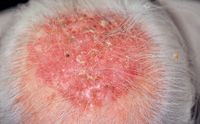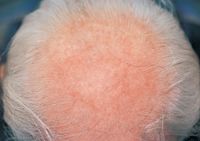- Acne
- Actinic Keratosis
- Aesthetics
- Alopecia
- Atopic Dermatitis
- Buy-and-Bill
- COVID-19
- Case-Based Roundtable
- Chronic Hand Eczema
- Chronic Spontaneous Urticaria
- Drug Watch
- Eczema
- General Dermatology
- Hidradenitis Suppurativa
- Melasma
- NP and PA
- Pediatric Dermatology
- Pigmentary Disorders
- Practice Management
- Precision Medicine and Biologics
- Prurigo Nodularis
- Psoriasis
- Psoriatic Arthritis
- Rare Disease
- Rosacea
- Skin Cancer
- Vitiligo
- Wound Care
Article
Innovative therapies, new technologies target inflammatory, immune mechanisms
Las Vegas - New technologies are bringing increasingly fine resolution to previously fuzzy images and ideas about disease pathways. That, in turn, is generating better-targeted therapies.

"In the past, we've used cryotherapy or cytotoxic topical agents for the treatment of actinic keratoses (AK) and surgery for squamous cell carcinoma (SCC) in situ and superficial basal cell carcinoma (BCC)," says James Q. Del Rosso, D.O., clinical assistant professor at the University of Nevada School of Medicine, Las Vegas. "Newer therapeutic concepts address the inability of the host to recognize antigens effectively."
With superficial BCC, the body is often trying to mount an immune response but can't do so successfully because BCCs lack Fas receptors. Treatment with imiquimod stimulates the body's innate immune response, which then triggers an adaptive response that upregulates Fas receptors on the surface of BCC, allowing lymphocytes to effectively attack the tumor.

To initiate therapy, Dr. Del Rosso recommends a once-a-day dose of topical imiquimod as follows: two to three times a week for AK, three times a week for SCC in situ, and five to seven times a week for superficial BCC. When brisk inflammation results, patients may be given a rest period of one to four weeks.
He says, "Topical 5-fluorouracil reduces actinic keratoses by producing an inflammatory reaction due to its toxic effect on nuclei. This is 'smoke after the fire' and it's associated with significant stinging and burning. The inflammation associated with topical imiquimod, on the other hand, is a response to the influx of lymphocytes and is not usually associated with adverse symptoms." (See photos.)
Clinical trials are showing that patients respond favorably to imiquimod as a primary treatment or in combination with ablative therapy. The drug is U.S. Food and Drug Administration (FDA)-approved for AK therapy. Approval for use with superficial BCC is pending.

"Collectively, tetracycline, doxycycline and minocycline have been used for over a century," notes Dr. Del Rosso. "Conventionally, we use them as antibiotics to reduce P. acnes, but dermatologists have noticed for years that acne can be controlled in some patients, using very low dosages."
These dosages - too small to promote antibiotic resistance in microbial populations - are described as "subantimicrobial." Dentistry got a jumpstart on research in this area, leading to FDA approval of doxycycline (20 mg twice daily) as a treatment for chronic periodontitis.
Dermatologists are now conducting similar experiments. One recent multicenter, double-blind, randomized trial of adults with acne vulgaris found that patients treated with 20 mg of doxycline hyclate twice a day had a significantly greater reduction in lesions (inflammatory, noninflammatory and comedonal) than the control group.
Another open clinical trial in rosacea found an 80 percent to 100 percent reduction in inflammatory lesions and a 50 percent reduction in erythema in patients using doxycycline (20 mg twice a day) for four weeks.
Newsletter
Like what you’re reading? Subscribe to Dermatology Times for weekly updates on therapies, innovations, and real-world practice tips.











